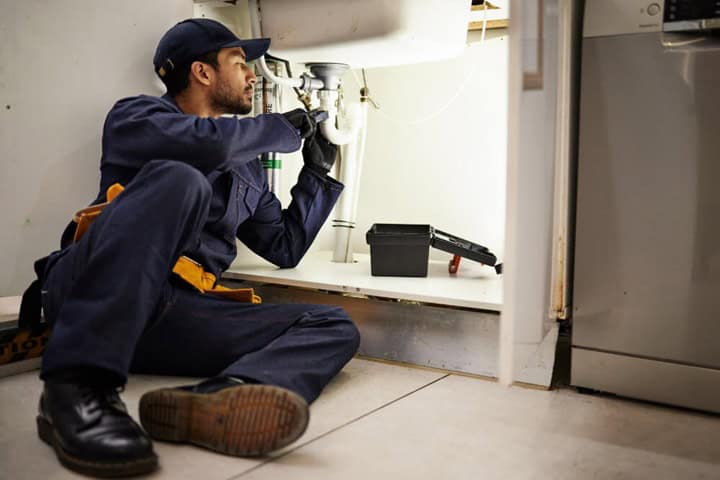Underfloor heating is great—until it stops working properly. What are the most common underfloor heating problems, and how can they be easily resolved?
If you’re dealing with underfloor heating problems, whether it’s a cold patch on the floor or a system that won’t switch off, you’re not alone. Like any other central heating system, underfloor heating is not without its faults. Fortunately, by recognising these problems with underfloor heating early on, they can easily be fixed before they get progressively worse. In this article, we will look at the most common underfloor heating problems, alongside how to spot the causes and resolve them. From single-zone issues and airlocks to faulty thermostats and pressure drops, we’ll cover both water underfloor heating, and electric underfloor systems. You’ll also learn when a quick reset is enough—and when it’s time to call a professional.
Key Points:
- What causes underfloor heating to stop working
- How to fix cold zones, stuck pumps, or inconsistent heating
- Signs of thermostat, actuator, and wiring issues
- Pressure problems and what they mean
- Common electric underfloor heating faults and how to spot them
- 9 Water Underfloor Heating Problems
- 1. Single Zone Is Not Heating Up
- 2. Underfloor Heating Actuator Problems
- 3. Underfloor Heating Thermostat Problems
- 4. Problems With Other Underfloor Heating Parts
- 5. Multiple Zones or Entire System Is Not Heating Up
- 6. All Zones Are Not Heating
- 7. Rise in Underfloor Heating System Pressure (Pressure Testing)
- 8. Expansion Vessel Issues
- 9. Pressure Drop on System (Boiler Locking Out)
- 6 Electric Underfloor Heating Problems
- 10. Electric Underfloor Heating Won’t Turn Off or Isn’t Warming Up
- 11. Floor Isn’t Getting Warm Enough
- 12. Damaged or Cut Heating Cable
- 13. Unexpected Running Costs
- 14. Mistakes During Installation
- 15. Airlocks and Pressure Problems (Shared with Wet Systems)
- Are underfloor heating systems supposed to be airtight?
- Why is my floor not reaching the desired temperature?
- FAQs
- Sources
9 Water Underfloor Heating Problems

Wet underfloor heating systems are reliable, but like any setup, they can sometimes stop working as expected. This is not helped by the fact that they can be more delicate to install than electric underfloor heating.
Below are some of the most common underfloor heating problems associated with wet underfloor heating systems, what causes them, and how to fix them.
1. Single Zone Is Not Heating Up/Underfloor Heating Not Working In One Room
Underfloor heating can be divided into multi-zone heating. If one part of your floor stays cold while the rest works fine, the problem is often easy to find and fix. This can happen in either older systems or new installations and usually points to one of a few common issues.
If your underfloor heating is not working in one room, this is likely because there is a problem with the thermostat not correctly sending a signal to the underfloor heating manifold. Of course, there could be an air bubble issue here, an actuator fault, or there is not enough water or electric passing through the single heating zone.
2. Underfloor Heating Actuator Problems
- Sticky pin valve underneath an actuator: Each actuator controls flow to a single loop of pipe. If one zone isn’t heating, remove the actuator and check if the small pin underneath is stuck. Use silicone spray or long-nose pliers to free it. This often solves the problem without needing to replace anything.
- Actuator has failed completely: If the pin moves freely but there’s still no heat, the actuator itself might have failed. This is often down to an electrical fault, especially if the underfloor heating won’t turn off or seems stuck on. At this point, it’s best to get an electrician to check the wiring or replace the actuator.
3. Underfloor Heating Thermostat Problems
- Faulty thermostat or low battery: Thermostats that run on batteries can lose signal or fail when batteries are flat. Always check and replace the batteries first. If that doesn’t work, follow the user manual to reset the thermostat. Still no luck? A faulty thermostat or wiring issue may be to blame, so an electrician should take a look.
- Thermostat not set up correctly (E1 & E2 errors): Thermostat displays showing an E1 or E2 error often just need resetting. You’ll find the reset instructions in the manual. These kinds of problems with underfloor heating are common and easy to fix if caught early.
4. Problems With Other Underfloor Heating Parts
- Air bubble or airlock in the UFH loop: Air can get trapped in the pipework, stopping water from circulating properly. To remove an airlock:
- Isolate all zones except the one that isn’t heating
- Remove the actuator
- Attach a hosepipe to the flow valve and connect to a mains cold tap
- Connect a second hose to the drain valve and direct to waste
- Open both valves and flush the zone with water
If unsure, a plumber can do this for you safely and quickly.
- Wiring issue: faulty connection or dry joint: Loose wires or dry solder joints can stop the actuator or thermostat from receiving power. This is one of the more technical underfloor heating problems, so it’s best left to an electrician.
- Flow gauges not opened properly on the manifold: Sometimes, the issue is as simple as a valve not being fully open. Check the flow gauges on your manifold and refer to your manual to adjust them correctly. Each system is slightly different.
5. Multiple Zones or Entire System Is Not Heating Up
If more than one zone—or even the whole system—isn’t heating up, the issue is likely larger than just one faulty part. These underfloor heating problems are usually tied to the system’s power supply, circulation, or control settings. While some things can be checked at home, most of these issues may still need professional attention.
- Circulation Pump Failure: The circulation pump moves warm water through the underfloor heating system. If it fails, no heat will reach any zone. This is typically an electrical issue and should be inspected by a qualified electrician.
- Pump Relay on Wiring Boards: If the pump relay is stuck or faulty, it won’t send the correct signal to start or stop the pump. This is another one of those problems with underfloor heating where an electrician should be called out to test and replace the faulty part.
- Isolation Valves Closed on the Manifold: Sometimes, the issue is mechanical rather than electrical. The isolation valves on the manifold may have been accidentally left closed. These levers should sit in line with the pipework when open. If they’re positioned at 90 degrees, the flow of water is blocked. This is a simple fix and can be done without tools.
- Blending Valve Pin Stuck: Blending valves regulate water temperature. If the pin underneath the thermostatic valve head is stuck, the valve won’t function correctly. Remove the white plastic head and check the pin. Use silicone spray or long-nose pliers to gently free it if stuck, then replace the valve head.
- Boiler Not Firing (No Signal): If the boiler isn’t firing at all, the system won’t produce heat. This could be due to a wiring issue or failed relay between the boiler and control system. A qualified electrician can test the wiring board and boiler signal to confirm the fault.
- No Power to the Wiring Boards: If the main power supply to the wiring boards is off, the entire system will shut down. Check your isolator switch—if it’s turned off or tripped, turn it back on. If it keeps tripping or there’s still no power, an electrician will need to investigate.
6. All Zones Are Not Heating Up
When no zones are producing heat, it’s usually a sign of a bigger issue affecting the whole system. These types of underfloor heating problems could relate to the boiler, the manifold, or the system’s power supply. While there are a few basic checks you can do yourself, most problems with underfloor heating at this scale should be handled by a heating engineer.
- Check Boiler Pressure and Operation: The first thing to check is whether the boiler is running at a proper pressure. If the pressure is too low, it often means there’s a leak somewhere in the system. A boiler that isn’t firing up at all could indicate a lack of signal from the wiring board or faulty connections.
- Confirm the boiler pressure gauge shows a normal reading (usually between 1 and 1.5 bar when cold).
- If the boiler isn’t firing, check the wiring and relays—or call an electrician to test them properly.
- If the opposite effect is occurring, check our guide on boiler pressure being too high.
- Check the Power Supply: Make sure the main isolating switch is turned on. If the switch has tripped or is off, none of the wiring boards will receive power, and the entire heating system will stop working. Turn the switch back on and see if the system restarts.
- Listen for the Circulation Pump: A quiet or silent pump could suggest a mechanical failure or loss of power. A working pump usually gives off a low whirring sound. If you can’t hear anything, it may be faulty, and an electrician or plumber will need to inspect it.
- Inspect the Manifold: If the issue isn’t the boiler or the power supply, the fault may lie with a manifold component—such as a stuck mixing valve, faulty actuator, or internal blockage. These are difficult to test without the right tools, so a professional should handle the inspection.
7. Rise in Underfloor Heating System Pressure (Pressure Testing)
Some water underfloor heating problems are first spotted during pressure testing. If the system pressure is too high, there may be several possible causes:
- Filling loop left on or letting by: Ensure both valves at the ends of the filling loop are fully closed and disconnect the loop.
- Restriction in the pipework: Pressure that changes with pump speed often points to airlocks or partial blockages.
- Pump location: If the pump is installed close to a valve, expect a temporary pressure change when it starts.
8. Expansion Vessel Issues
A common cause of rising pressure is a failed diaphragm inside the expansion vessel.
- Press the Schrader valve underneath the vessel—if water escapes, the diaphragm has ruptured and the vessel needs replacing.
- If no water escapes but pressure keeps rising, it could be low on air. Use a foot pump to increase pressure to around 2 bar, then refill the water side to normal levels.
9. Pressure Drop on System (Boiler Locking Out)
Not all underfloor heating problems involve rising pressure—some systems lose pressure instead. A sudden pressure drop often causes the boiler to lock out. To find the cause:
- Look for leaks around visible pipework, joints, the cylinder, and all valves.
- Re-pressurise the system, then isolate each side of the manifold one at a time.
- Watch which side drops in pressure—this shows you where the leak is happening.
- Don’t forget to check the pressure relief valve, boiler blow-off valve, and expansion vessel.
Leaks and pressure-related problems with underfloor heating can seem difficult to trace, but isolating zones and watching pressure behaviour can help narrow it down. In most cases, calling in a qualified plumber is the safest route.
6 Electric Underfloor Heating Problems

Electric underfloor heating systems are often chosen due to being easier to install and have low maintenance needs. However, that doesn’t mean they’re completely free from issues.
The good news is that many electric underfloor heating problems are easy to spot—and in some cases, easy to fix. Below are the most common problems with underfloor heating in electric systems, how to identify them, and what to do next.
10. Electric Underfloor Heating Won’t Turn Off or Isn’t Warming Up
One of the most reported common underfloor heating problems is when the system either doesn’t heat up or won’t switch off. In most cases, this comes down to a thermostat issue or faulty wiring.
- Check the thermostat settings: Ensure it’s programmed correctly and isn’t stuck in a mode that overrides scheduled heating.
- Test the floor sensor: This small probe communicates with the thermostat and regulates temperature. If it’s faulty or disconnected, the system won’t respond properly.
- Inspect wiring connections: Loose or broken wiring can interrupt communication between the thermostat and the heating cable. This should be checked by a qualified electrician.
If these steps don’t work, it’s best to call an electrician to carry out further testing.
11. Floor Isn’t Getting Warm Enough
If your electric underfloor heating feels lukewarm—or not warm at all—there are a few common causes:
- Incorrect thermostat settings: Increase the temperature slightly or check for restrictions like time schedules or energy-saving modes.
- Low system power output: Some systems aren’t powerful enough to heat larger areas, especially if they weren’t sized correctly during installation.
- Poor insulation: Heat can escape downwards if your subfloor or room isn’t properly insulated. This is a common reason why some floors never seem to reach the desired temperature.
12. Damaged or Cut Heating Cable
If you’ve accidentally damaged or cut the heating cable during floor installation or renovation, don’t panic. Using the wrong fix could lead to further damage or safety risks. If in doubt, give us a call and we’ll help guide you.
13. Unexpected Running Costs
Electric systems typically cost more to run than warm water systems, especially over larger areas. If your energy bill is higher than expected:
- Review thermostat programming: Lower the set temperature, adjust schedules, or reduce how long the heating runs each day.
- Check insulation: Poor insulation will force your system to work harder to maintain heat.
- Consider room size: Electric underfloor heating is best suited to smaller spaces like bathrooms or en-suites.
These factors often lead people to think there’s a fault, when it’s more to do with setup and expectations.
14. Mistakes During Installation
Electric systems are usually straightforward to install, but mistakes do happen. Common installation issues include:
- Loose or badly positioned temperature probes
- Incorrect spacing of heating cables
- Improper insulation under the matting
If you suspect something wasn’t installed properly, it’s worth getting a professional to inspect the system—especially before any floor coverings are laid.
15. Airlocks and Pressure Problems (Shared with Wet Systems)
While electric underfloor systems don’t suffer from water-based airlocks like warm water systems, some problems with underfloor heating are still related to pressure and insulation:
Are underfloor heating systems supposed to be airtight?
Slight pressure drops over time are normal in any heating system, especially as components age. But if you’re seeing rapid or repeated drops in pressure, this could suggest a leak or trapped air.
- Recurring airlock problems: These are more common in water underfloor systems, but if your system is losing pressure and performance, it may be worth asking your heating engineer to run an air escape cycle at your boiler’s next service.
Why is my floor not reaching the desired temperature?
If everything appears to be working, but the floor still feels cooler than expected, try the following:
- Check the flow temperature on the boiler and manifold. A large difference could point to a faulty temperature sensor.
- Test the boiler pressure. Low or unstable pressure might be due to air, sediment build-up, or a small leak.
- Inspect the pipes between the boiler and manifold. Leaks in this area can reduce efficiency and cause pressure drops.
In conclusion, it is clear that underfloor heating problems can happen from time to time, whether you’re using a wet or electric based system. Thankfully, most issues—like cold spots, faulty thermostats, or pressure drops—can be identified with simple checks and fixed quickly; it is rarely down to the manufacturer’s fault. Hopefully, this guide has covered the most common problems with underfloor heating that you may likely experience at some point with your new underfloor heating system, and what steps to take next. If in doubt, or the problem continues, it’s always worth getting a qualified professional to take a closer look.
Further reading:
Check out our other guides regarding underfloor heating maintenance –
- How to bleed underfloor heating
- How to wire underfloor heating
- Underfloor heating manifold explained
- Signs of underfloor heating leak
- Repair underfloor heating
FAQs
How do I reset my underfloor heating system?
To reset your underfloor heating, press and hold the Mode and i buttons on your thermostat for around 10 seconds. After a few seconds, the system will switch to test mode, which triggers a reset. Always check your user manual, as the process may vary slightly between models.
Does underfloor heating often stop working?
Most underfloor heating problems are rare, especially when the system has been properly installed and maintained. If something does go wrong, it’s often down to a thermostat setting, low battery, or minor wiring issue—all of which are usually quick to fix.
Which type of flooring works best with underfloor heating?
Ceramic and stone tiles are ideal for underfloor heating because they transfer heat quickly and evenly. Other options like laminate or engineered wood can work too, but always check they’re rated for use with underfloor systems. Discover the best flooring for underfloor heating.
Sources
Tado. (2024) My Smart Radiator Thermostat displays an E1, E2 or E4 error. How can I fix this? [online] Available at: https://support.tado.com/en/articles/3482479-my-smart-radiator-thermostat-displays-an-e1-e2-or-e4-error-how-can-i-fix-this [accessed 14/04/2025]
